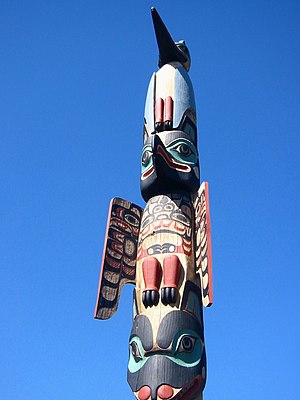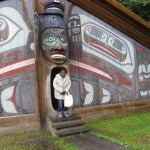
- Image via Wikipedia
We arrived at the Totem Bight State Park under a light drizzle. This park is a former Native village belonging to the Tlingit and Haida tribes. The park was abandoned when the natives moved to other communities to find work. The totem poles they left behind were soon overgrown by forests until the US Forest Service began a program of reconstructing the poles. Totem poles are skilfully carved from cedar wood and are used to depict various things, such as legends (story poles), or as grave markers (mortuary poles) or to mark some momentous occasion. Many of the Tlingit and Haida stories pay tribute to the chief, Raven, who is considered to be a symbol of the Creator. He is usually distinguished by his long, straight beak. Totem poles are usually raised during a potlach or celebration, in which the entire village takes part.
In the middle of the park stands a model of a clanhouse which was built in Native villages in the early 19th century. Built of wood, the house consists of just one room with a totem pole standing in each of the four corners. It is said that 30 to 50 people would have shared this house. We entered the house through a regular door, which was made for visitors, but the original door is a hole about 5 ft high x 4 ft wide hewn out of the side of the house. We had to bend to pass through this door and had fun taking pictures in it. I stood in front as you can see in the picture below, as I didn’t want to get stuck.
If you plan to visit Alaska, make Ketchikan a part of your itinerary. Its natural beauty, majestic wildlife, fascinating history and culture will leave a lasting impression on you. There are many tour companies that make it easy for you to see as many attractions as you wish. You can choose to travel by motor coach, Hummers or horse-drawn trolleys, or if you favor the water, you can go by high-speed boats, semi-submersibles and amphibians.
Related articles
- The totem pole (white-pebble.net)








October 24th, 2010 at 12:51 pm
FYI, Thought you might like to know there is another Blog Jog Day scheduled for Nov 21st. If you’re interested, go to http://blogjogday.blogspot.com to learn more.
Have a great day!!!